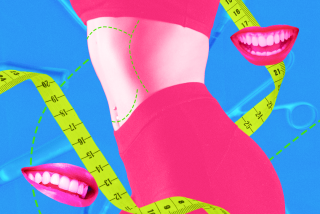The telltale signs of eating disorders
- Share via
Photographs of gaunt teenagers appear regularly in magazine articles about anorexia; bulimia and binge-eating disorders have been featured in many TV talk shows and movies -- and still many eating disorders go undiagnosed until they’ve taken a physical toll.
One woman I know suffered from anorexia as a young adult, yet failed to notice telltale signs in her teenage daughter. It wasn’t until her daughter began complaining of physical symptoms that she recognized what was happening.
“She came to me one day holding a handful of her hair and asked, ‘What would make my hair fall out?” the woman recalls. “A couple of weeks later, she came to me badly bruised and asked, ‘What would make me bruise so much?’ ” By the time the mother realized the problem, her already slim daughter had lost 10 pounds and her weight had dropped below 100.
An estimated 8 million Americans suffer from eating disorders, according to the National Assn. of Anorexia Nervosa and Associated Disorders. Although more than 90% are women or girls between the ages of 12 and 25, increasing numbers of boys and older adults are being affected as well.
Eating disorders are more easily treated when diagnosed early, but if allowed to progress, they can result in serious medical complications.
Bulimia, characterized by repeated binging and purging (throwing up after eating), can cause dangerous fluid imbalances as well as inflammation of the esophagus and stomach.
The severe caloric restriction associated with anorexia can disrupt liver and kidney function and trigger abnormal heart rhythms. And the frequent episodes of compulsive overeating associated with a binge-eating disorder can lead to significant weight gain, contributing to high blood pressure and diabetes.
Unfortunately, in up to 50% of cases, the early signs and symptoms are overlooked even by the person’s doctor.
One reason for this: People with eating disorders are typically secretive -- and sometimes deceptive -- about their problems.
The teenager described above often played her parents off against each other. “She’d tell me she ate when her dad was in the kitchen and tell my husband she ate when she was with me,” the mother recounts.
Another reason is that even dangerous weight changes can be missed. Some people use baggy clothes to disguise dramatic losses or gains; others don’t draw attention until they become “too thin” or “too heavy.”
Almost always, however, the signs are there -- so-called red flags that suggest a problem. Abnormal eating patterns are, perhaps, the most obvious warning signal: the repeated refusal of food by children or adults who claim that they’re not hungry, or the extraordinary volume of food consumed by those who binge eat.
If you’re worried that someone you know has an eating disorder, observe how much he or she eats (without calling too much attention to the fact that you’re doing it).
Does she eat until she’s uncomfortably full? Does he do nothing more than push food around his plate? Keep in mind that it’s not what the person does at one particular meal that matters, but rather the overall eating patterns.
Pay attention, as well, to the kinds of food the person is eating. Are specific foods, such as those high in calories or fat, strictly avoided? And although restraint around sweets is to be applauded, someone who steadfastly refuses to ever eat them may be displaying excessive concern about gaining weight.
Exercise patterns can serve as another tip-off. Many anorexics and bulimics often exercise frequently and intensely as a way to control their weight, and become anxious if they miss a workout. Attitudes about food and self-perception of physical appearance also can be telling. Anorexics, for example, tend to view themselves as fat even though they may be very thin; bulimics often display excessive concern about their shape and bodyweight.
Ultimately, physical signs of malnutrition may appear in people with eating disorders. Hair loss and dry skin are among the most common. They also may begin to bruise or bleed very easily or complain that they feel cold, dizzy, weak or tired.
Finally, in children, growth patterns may provide clues that a problem exists. The American Academy of Pediatrics recommends annual visits to the doctor throughout adolescence. At the doctor’s office, children will get weighed and measured, and there’s no cheating that.
*
Dr. Valerie Ulene is a board-certified specialist in preventive medicine practicing in Los Angeles. The M.D. appears the first Monday of the month.
More to Read
Sign up for Essential California
The most important California stories and recommendations in your inbox every morning.
You may occasionally receive promotional content from the Los Angeles Times.













